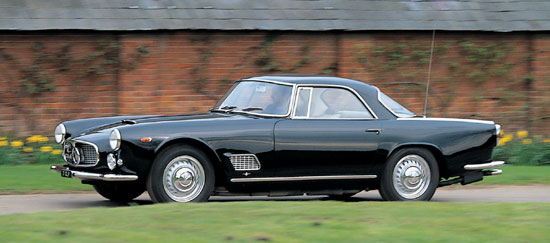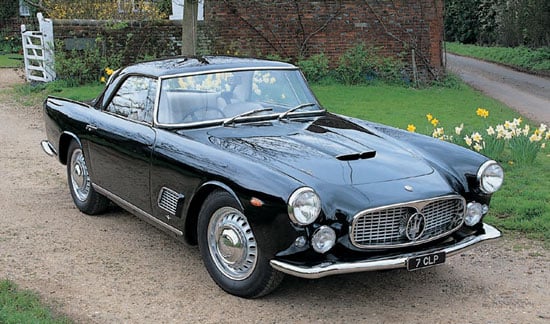
The following is an extract an article from November's Auto Italia magazine. For access to the full feature, plus articles on driving the Ferrari F430, the 2004 Vernasca Silver Flag hillclimb, driving the World Champion Lancia rally cars and much more, see www.auto-italia.co.uk
Along with pin-striped suits and red Porsches, the late ’80s will be remembered for the classic car boom. The popular view is of a time when anything on four wheels that could remotely support a ‘classic’ tag became stocks and shares to hungry investors, eager to move their money into the next big bubble and so ousting lowly enthusiasts from their own hobby.
Even today, some 14 years after the bubble burst, those hobbyists still bemoan the era of cars for money, yet they forget one thing. As the values of classic cars rose dramatically and demand outstripped supply, even the basket cases were suddenly worth restoring. The classic car boom saved a great many cars that would otherwise have met their maker. This Maserati is one such example.
Years in the exotic car poverty trap had done the Maserati 3500GT no favours. While the more popular and newer cars such as Ghiblis and Boras found a ready market, the older car was almost an unwanted gift throughout the ’70s and early ’80s. Run only by eccentrics with a spanner in their back pocket, the 3500GT as a type deteriorated through lack of value and many of the 1900 cars produced between 1957 and 1964 disappeared to keep others alive or to feed the dreaded Special builders.
Those that were left had their once graceful Touring of Milan lines, handcrafted from aluminium, subjected to the cheap attentions of the unscrupulous bodyshop, in a vain attempt to make presentable what was intrinsically rotten. And as the parts supply became ever more difficult and expensive, Modena originals were replaced with ‘the next best’ thing. Bastardisation knew no bounds in the pursuit of a cheap fix as a proper restoration was out of the question. Then, in the mid-80s, on the back of the ascendance of more obvious exotica, values of the by now obscure 3500GT first hardened and then followed the upward spiral.
The last owner of this car had always liked the idea of a 3500GT but by the time he had the wherewithal, the goalposts had changed. He reasoned that soon this model, like many others, could be out of his range once again and therefore acted too quickly in buying this car: ‘car’ being a fairly loose term to describe the various piles of parts that actually arrived. Clearly, a restoration would follow and, in the thinking of the time, would cost less than the car would ultimately be worth, while providing a useful opportunity to budget the total cost over a long period.
The restoration began in earnest in 1989. Slowly of course, because everyone else had the same idea and restoration companies throughout the UK were deluged with profit-motivated customers eager to buy-restore-sell in the blink of an eye. A year later, all of those companies would be glad of the work.

An Aston Martin specialist in Surrey, Medcalf & Co, had been charged with the body restoration of the 3500, its similarity to Touring of Milan’s other ’50s masterpiece, the Aston DB4, being an overriding factor in the choice. Medcalf’s men stripped away the rotten aluminium skin to reveal the bare, oval-tube chassis and the intricate innards of the Superleggera construction. Intent on doing the best job possible, they recommended a complete new outer body fabricated by their craftsmen. At that time, no 3500 restoration had gone further. Meanwhile, Bill McGrath Maserati took delivery of the engine and other mechanical parts to commence the second half of the work. A repaired and phosphate-dipped chassis arrived in Kimpton some time later for fitting of the mechanics before being returned to Surrey for body fitting.
And then the bubble burst. For the classic car world, it is like a Kennedy thing. Everyone can remember where they were when they realised that the boom was over. I first heard the news from a dealer friend who had been sitting in the front row at the 1990 Christie’s auction at Monaco. Only a few weeks earlier the money had flowed like champagne, but that night it was like being at a meeting of Alcoholics Anonymous. All over the UK, hatches were battened down ahead of the inevitable recession.
For the dealers, it was an instant nightmare. Overnight, the value of their stock had quartered but for the restorers, the effects of the recession took longer to filter through. First bookings slowed down, then current projects were stopped indefinitely, and then the court cases began. Investors with their backs against the wall sought compensation from the ‘slow’ restorers who had not finished their projects before the change in the market. Many restorers went to that wall themselves and those that survived found their workshops littered with unfinished projects, now worth less than the charges to date.
The trouble was that proper restoration was always going to be a long and painstaking process, something that the fly-by-night investors could never grasp. But for the 3500GT owner, a decision had to be made: to carry on, knowing that the cost of completing the car could never be recouped, or to cut his losses. The restoration continued. In fact, it turned into a crusade to create the best possible example. In 1998 this early, right-hand drive car finally ran again for the first time in 20 years.
Five years after the restoration had been completed, the car had covered a mere 500 miles. It languished in professional storage, its owner unable to find time in his own schedule to actually use the car. After much soul-searching, he realised that he had to sell. It was a painful decision and one based not on financial criteria as much as personal guilt. Having saved the car from post-boom oblivion, it now needed to be driven, enjoyed and celebrated as one of the best of its type. The only way to achieve this was to find a like-minded buyer.
In the current classic car market, buyers are much more cautious. Those with long memories still have that Kennedy moment and newer enthusiasts have the perils of overpaying drummed into them by the myriad buyers’ guides. And while all of these guides say ‘buy the best example for it will be cheaper in the long run’, no one wants to create a new ‘highest’ price. That this 3500GT, having had a total restoration, could not achieve for 18 months a price of even half its restoration costs was evidence of this.
Earlier this year, the car was sold. The new owner is well aware that he will benefit from the patronage of his predecessor but also of the responsibility of long-term ownership. He knows full well that this car could quite easily have been scrapped, were it not for the boom, but that saving it became an act of pure passion. He also knows that what he must add to the process is what the car was built for – driving.
With thanks to Bill McGrath Maserati - www.classicmaseratis.co.uk - specialists in the restoration and preparation of classic and Biturbo era Maseratis.
|
Words by Andy Heywood and Pictures courtesy of Phil Ward and Auto Italia magazine.
See www.auto-italia.co.uk or call 01858 438817 for back issues and subscriptions. |



